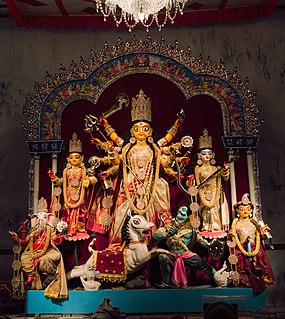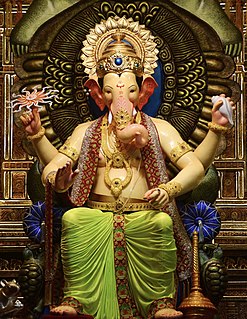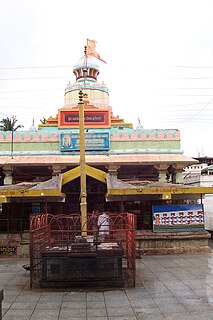
Parvati, Uma or Gauri is the Hindu goddess of fertility, love, beauty, harmony, marriage, children, and devotion; as well as of divine strength and power. Known by many other names, she is the gentle and nurturing form of the Supreme Hindu goddess Mahadevi and one of the central deities of the Goddess-oriented Shakti sect called Shaktism. She is the Mother goddess in Hinduism, and has many attributes and aspects. Along with Lakshmi and Saraswati, she forms the Tridevi of Hindu goddesses.

Durga Puja, also known as Durgotsava, or Sharodotsava, is an annual Hindu festival originating in the Indian subcontinent which reveres and pays homage to the Hindu goddess, Durga. It is particularly popular and traditionally celebrated in the Indian states of West Bengal, Assam, Odisha, Tripura, the country of Bangladesh, the diaspora from this region, and in Mithilanchal regions of Bihar and Nepal. The festival is observed in the Indian calendar month of Ashwin, which corresponds to the months of September–October in the Gregorian calendar, and is a ten-day festival, of which the last five are of significance. The puja is performed in homes and in the public, the latter featuring temporary stage and structural decorations. The festival is also marked by scripture recitations, performance arts, revelry, gift giving, family visits, feasting, and public processions. Durga puja is an important festival in the Shaktism tradition of Hinduism.

Ganesh Chaturthi, also known as Vinayaka Chaturti, or Vinayaka Chaviti is a Hindu festival celebrating the arrival of Ganesh to earth from Kailash Parvat with his mother Goddess Parvati/Gauri. The festival is marked with the installation of Ganesh clay murtis privately in homes and publicly by Shri Bal Gangadhar Tilak popularly known as Lokmanya Tilak in Pune in the year 1893 on elaborate pandals. Observations include chanting of Vedic hymns and Hindu texts such as, prayers and vrata (fasting). Offerings and prasāda from the daily prayers, that are distributed from the pandal to the community, include sweets such as modaka as it is believed to be a favourite of Lord Ganesh. The festival ends on the tenth day after start, when the idol is carried in a public procession with music and group chanting, then immersed in a nearby body of water such as a river or sea. In Mumbai alone, around 150,000 statues are immersed annually. Thereafter the clay idol dissolves and Ganesh is believed to return to Mount Kailash to Parvati and Shiva. The festival celebrates Lord Ganesh as the God of New Beginnings and the Remover of Obstacles as well as the god of wisdom and intelligence and is observed throughout India, especially in the states such as Maharashtra, Karnataka, Rajasthan, Madhya Pradesh, Andhra Pradesh, Telangana, Odisha, Goa, West Bengal, Gujarat, Chhattisgarh and Tamil Nadu. Ganesh Chaturthi is also observed in Nepal and by the Hindu diaspora elsewhere such as in Australia, New Zealand, Canada, Singapore, Malaysia, Trinidad and Tobago, Guyana, Suriname, other parts of the Caribbean, Fiji, Mauritius, South Africa, United States, and Europe. In the Gregorian calendar, Ganesh Chaturthi falls between 22 August and 20 September every year.
Mahalakshmi Vratha or Varalakshmi Vratam is a sacred day in Hinduism. The ceremony is performed by men or women on the Friday before the full moon in the month of Shravana in the Hindu calendar. Those who cannot perform it on that day, can do it on any other Friday in that month. This is an important Vratha, meaning a vowed religious observance in Sanskrit. Varamahalakshmi Vratham is performed more commonly in the southern Indian states of Karnataka, Andhra Pradesh, Tamil Nadu and also in parts of Maharashtra and Odisha. The 2017 dates were 17 August - 12 September.

Mundkur is a village in Karkala Taluk, Udupi district, Karnataka, India. The Durga Parameshwari temple located here was built circa 9th century AD.

Kolluru or Kollur is a small temple-town in Byndoor Taluk in Udupi district of Karnataka state, India. It is situated about 27 km from Byndoor town. This village lies at the foot of the Western Ghats and is famous for the Mookambika temple, a Hindu pilgrim center. The village is located on the banks of Agnitheertha and Souparnika river.
Kolkata has many festivals throughout the year. Durga Puja is the largest festival of West Bengal, and it features colourful pandals, decorative idols of Hindu goddess Durga and her family, lighting decorations and fireworks. Other major festivals are Diwali, Kali Puja, Holi, Saraswati Puja, Poush Parbon, Poila Boishakh, etc.

Teej is the generic name for a number of Hindu festivals that are celebrated by women. Haryali Teej and Hartalika Teej welcome the monsoon season and are celebrated primarily by girls and women, with songs, dancing and prayer rituals. The monsoon festivals of Teej are primarily dedicated to Parvati and her union with Shiva. Women often fast in celebration of Teej. Hartalika Teej is celebrated in all parts of Nepal and most of the parts of North India .Teej festivals are traditionally observed by women to celebrate the monsoons during the months of Shravan and Bhadrapada in the Hindu calendar. Women often pray to Parvati and Shiva during Teej.

Bonalu is a Telangana traditional Hindu festival centered on the Goddess Mahakali. This festival is celebrated annually in the twin cities of Hyderabad and Secunderabad, as well as in other parts of the state. It is celebrated in the month of Ashada Masam, which is around July and/or August. Special "poojas" are performed for Yellamma on the first and last day of the festival. The festival is also considered a thanksgiving to the Goddess for fulfillment of vows.

Thirumandhamkunnu Temple is a historically significant Hindu temple in Angadipuram, which was the capital of Valluvanad Rajavamsham,in Malappuram district, Kerala state, South India. The temple deity, Thirumandhamkunnil amma, was the paradevatha of the kings of Valluvanad, the local feudal kings ruled the area in the Middle Ages. The Nair warriors of Valluvanad king set out from this temple to Thirunavaya, to participate in the famous Mamankam festival. A memorial structure called the chaver thara can be found in front of the main entrance of the Thirumanthamkunnu Temple.

Banashankari Devi Temple is a Hindu shrine located at Cholachagudd near Badami, in Bagalkot district, Karnataka, India. The temple is popularly called Banashankari or Vanashankari since it is located in the Tilakaaranya forest. The temple deity is also called the Shakambhari, an incarnation of the goddess Parvati.

Bathukamma is floral festival celebrated predominantly in Telangana and some parts of Andhra Pradesh. Every year this festival is celebrated as per Sathavahana calendar for nine days starting Bhadrapada Pournami till Durgashtami, usually in September–October of Gregorian calendar. Bathukamma is celebrated for nine days during Durga Navratri. It starts on the day of Mahalaya Amavasya and the 9-day festivities will culminate on "Saddula Bathukamma" or "Pedda Bathukamma" festival on Ashwayuja Navami, popularly known as Durgashtami which is two days before Dussehra. Bathukamma is followed by Boddemma, which is a 7-day festival. Boddemma festival that marks the ending of Varsha Ruthu whereas Bathukamma festival indicates the beginning of Sarad or Sharath Ruthu.
Atla Taddi is a traditional festival celebrated by married Hindu women of Andhra Pradesh for the health and long life of their husbands. It occurs on the 3rd night after the full moon in Aswiyuja month of Telugu calendar, and falls in either September or October in the Gregorian calendar. It is the Telugu equivalent of Karva Chauth, which is celebrated by north Indian women the following day.

Lakshmi Puja or Lakshmi Pooja, is a Hindu religious festival that falls on Amavasya of Krishna Paksha in the Vikram Samvat Hindu calendar month of Kartik, on the third day of Deepawali and is considered as the main festive day of Deepawali.
Bengaluru Karaga is one of the oldest festivals celebrated in the heart of Bengaluru (ಬೆಂಗಳೂರು). Bengaluru Karaga is primarily a well-known tradition of 'Vahnikula Kshatriyas Thigala' community in southern Karnataka. The Karaga festival is generally led by the men of the community. There is a legend which gives them this privilege. Vahnikula Kshatriyas believe that in the last part of the Mahabharatha, when the Pandavas were shown a glimpse of hell, one last Asura (Demon) called Thimirasura was still alive.

Navaratri is a Hindu festival that spans nine nights and is celebrated every year in the autumn. It is observed for different reasons and celebrated differently in various parts of the Indian cultural sphere. Theoretically, there are four seasonal Navaratri. However, in practice, it is the post-monsoon autumn festival called Sharada Navaratri that is the most observed in the honor of the divine feminine Devi (Durga). The festival is celebrated in the bright half of the Hindu calendar month Ashvin, which typically falls in the Gregorian months of September and October.

Haragapur is a village in Belgaum district in the southern state of Karnataka, India. It is attached to NH-4. Places to visit are Shivaji Fort, Mallikarjun Temple & Navanath Mandir. Village is located on Hilltop. Language spoken here is Kannada (ಕನ್ನಡ)

The Telugu Hindu wedding ceremony is the traditional wedding ceremony of the Telugu people in India. In the 19th century, the ceremony could last up to sixteen days. In modern times, it can last two or more days, depending on the family's financial and social status. The pelli or wedding is considered the strongest of social bonds, and is said to spiritually merge two souls opening the doors to gruhastaashramam. There is a Telugu saying that "Marriage is supposed to be a family union and not an individual formality." However, with changing mindset of the younger generation and due to globalization, marriage these days is being mainly focused solely on the union of the young couple only.

Sindur Khela, literally meaning 'vermillion game', is a Bengali Hindu tradition where women smear each other with sindur on Vijayadashami, the last day of the Durga Puja. On the day of the Vijayadashami after the conclusion of the ritual worship, married Bengali Hindu women apply sindur on the forehead and feet of the goddess and offer sweets to her. Then they put sindur on each other's faces and offer sweets to each other.

Sri Ramalinga Sowdeswari Amman is a Hindu deity, also known as Sri Chowdeshwari Devi. This goddess is worshiped as Sri Chowdeshwari Devi or Sri Ramalinga Sowdeswari Amman in three forms: Shakti, Chamunda, and Jyothi. Her other names are Banashankari and Soodambigai. She is Kuladevatha of Devanga people.
























